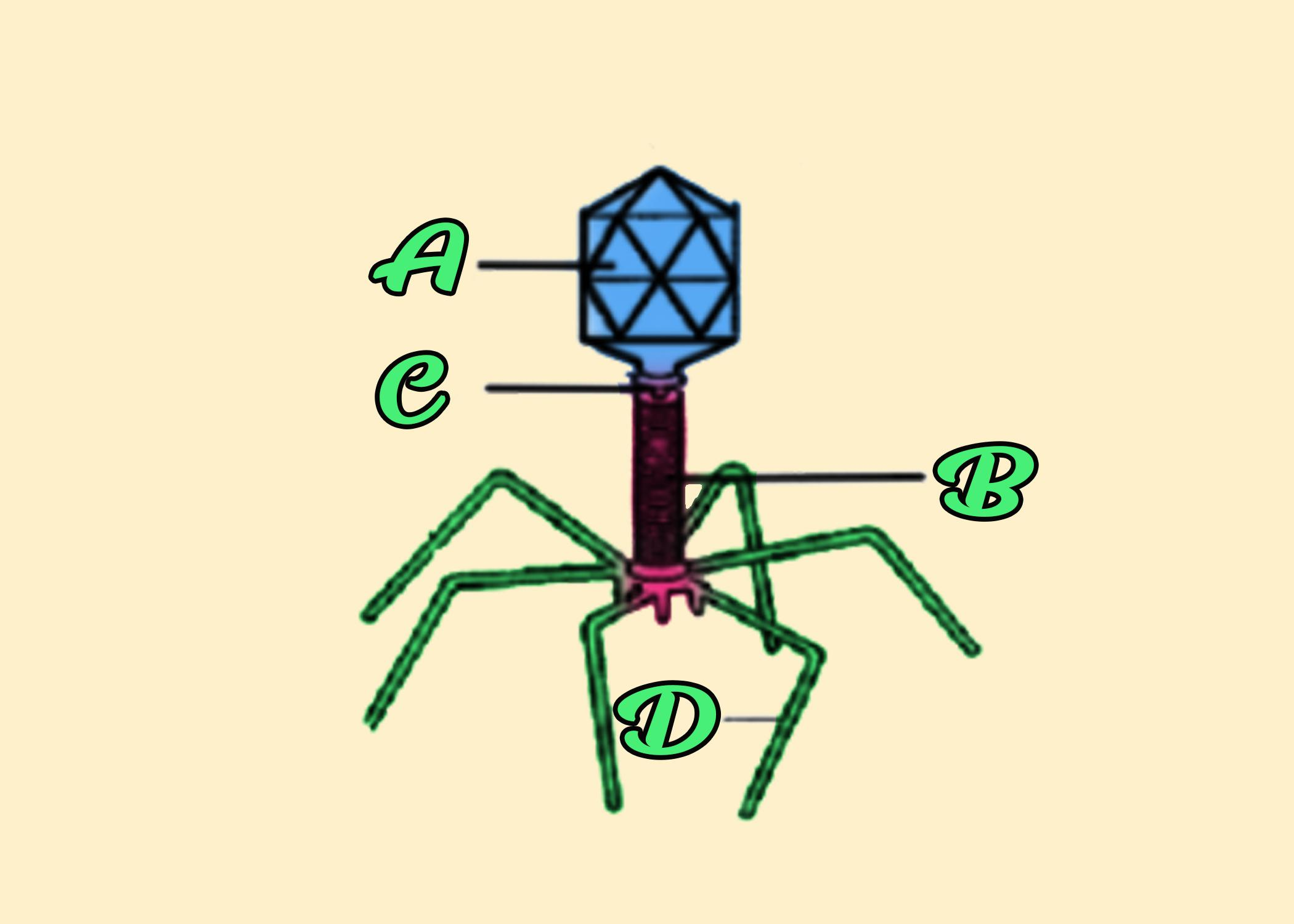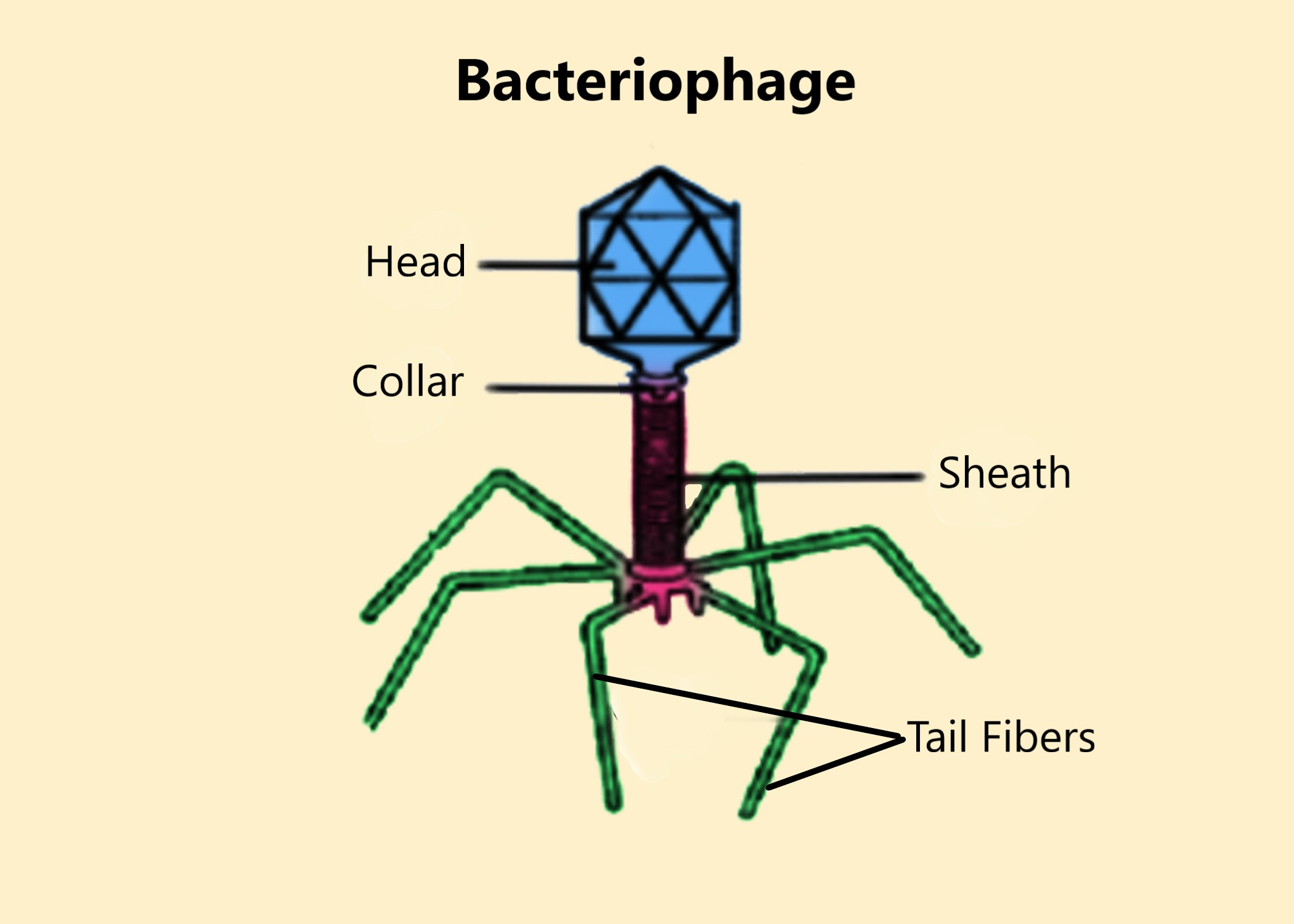
Given below is the diagram of a bacteriophage.

In which one of the options all the four parts A, B, C, and D are correct?
(a)A - Tail fibres, B - Head, C - Sheath, D - Collar
(b)A - Sheath, B - Collar, C - Head, D - Tail fibres
(c)A - Head, B - Sheath, C - Collar, D - Tail fibres
(d)A - Collar, B - Tail fibres, C - Head, D - Sheath

Answer
451.5k+ views
Hint: This is the virus that infects bacteria. It is also called bacteria eater and is composed of a nucleic acid molecule that is surrounded by a protein structure.
Complete answer:
Bacteriophages are a virus that infects bacteria. Phage means eaters of bacteria. The T4 phage that infects the bacterium Escherichia coli consists of a polyhedral head attached to a helical tail, a shape commonly found in bacteriophages. In between the head and tail, there exists a sheath and a collar. Many phages have tail fibres that help the virus to attach to the host cell.
Additional Information:
All the bacteriophages are made up of a nucleic acid molecule surrounded by a protein structure.
A bacteriophage attaches itself to a bacterium (host cell) and infects it. After assembling the new bacteriophages burst out of the bacterium.
It removes a portion of bacterial DNA of the host cell during the infection process and then transfers this DNA into the genome of new host cells.
The bacteriophages are characterised by a high specificity only to bacteria at infection and are very common in all environments. Their number is directly related to the number of bacteria present in the biosphere.
The scientists are estimating that more than 1030 tailed phages are present in the biosphere.
So, the correct answer is option (c) ’ A - Head, B - Sheath, C - Collar, D - Tail fibres’.

Note: Bacteriophages or phages are viruses that infect and use only bacterial resources for their growth and reproduction.
Escherichia virus T4 is that species of bacteriophages that infect only Escherichia coli bacteria.
Phages are common in soil and readily isolated from faeces and sewage, as well as being very abundant in freshwater and oceans with an estimate of more than 10 million virus-like particles in 1 mL of seawater.
Complete answer:
Bacteriophages are a virus that infects bacteria. Phage means eaters of bacteria. The T4 phage that infects the bacterium Escherichia coli consists of a polyhedral head attached to a helical tail, a shape commonly found in bacteriophages. In between the head and tail, there exists a sheath and a collar. Many phages have tail fibres that help the virus to attach to the host cell.
Additional Information:
All the bacteriophages are made up of a nucleic acid molecule surrounded by a protein structure.
A bacteriophage attaches itself to a bacterium (host cell) and infects it. After assembling the new bacteriophages burst out of the bacterium.
It removes a portion of bacterial DNA of the host cell during the infection process and then transfers this DNA into the genome of new host cells.
The bacteriophages are characterised by a high specificity only to bacteria at infection and are very common in all environments. Their number is directly related to the number of bacteria present in the biosphere.
The scientists are estimating that more than 1030 tailed phages are present in the biosphere.
So, the correct answer is option (c) ’ A - Head, B - Sheath, C - Collar, D - Tail fibres’.

Note: Bacteriophages or phages are viruses that infect and use only bacterial resources for their growth and reproduction.
Escherichia virus T4 is that species of bacteriophages that infect only Escherichia coli bacteria.
Phages are common in soil and readily isolated from faeces and sewage, as well as being very abundant in freshwater and oceans with an estimate of more than 10 million virus-like particles in 1 mL of seawater.
Recently Updated Pages
Glucose when reduced with HI and red Phosphorus gives class 11 chemistry CBSE

The highest possible oxidation states of Uranium and class 11 chemistry CBSE

Find the value of x if the mode of the following data class 11 maths CBSE

Which of the following can be used in the Friedel Crafts class 11 chemistry CBSE

A sphere of mass 40 kg is attracted by a second sphere class 11 physics CBSE

Statement I Reactivity of aluminium decreases when class 11 chemistry CBSE

Trending doubts
The reservoir of dam is called Govind Sagar A Jayakwadi class 11 social science CBSE

10 examples of friction in our daily life

What problem did Carter face when he reached the mummy class 11 english CBSE

Difference Between Prokaryotic Cells and Eukaryotic Cells

State and prove Bernoullis theorem class 11 physics CBSE

Proton was discovered by A Thomson B Rutherford C Chadwick class 11 chemistry CBSE




